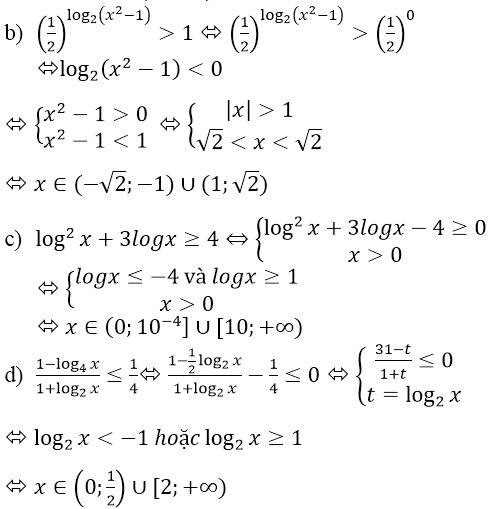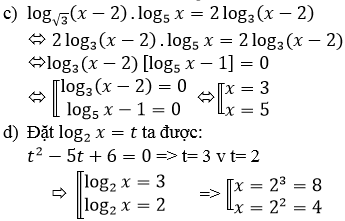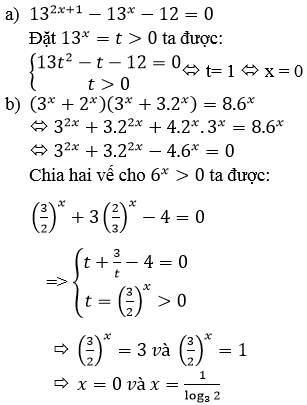
Hãy nhập câu hỏi của bạn vào đây, nếu là tài khoản VIP, bạn sẽ được ưu tiên trả lời.


d) Phương trình đã cho tương đương với :
\(2^{3x}+2^x.3^{2x}=2.3^{2x}\Leftrightarrow\left(\frac{2}{3}\right)^{2x}+\left(\frac{2}{3}\right)^x-2=0\)
Đặt \(t=\left(\frac{2}{3}\right)^x,\left(t>0\right)\) Phương trình trở thành
\(t^3+t-2=0\) hay \(\left(t-1\right)\left(t^2+t+2\right)=0\)
Do \(t^2+t+2=\left(t+\frac{1}{2}\right)^2+\frac{7}{4}>0\) nên \(t-1=0\) hay t=1
Từ đó suy ra \(\left(\frac{2}{3}\right)^x=1=\left(\frac{2}{3}\right)^0\Leftrightarrow x=0\)
Vậy phương trình có nghiệm duy nhất \(x=0\)
c) Điều kiện \(x\ne0\). Chia cả 2 vế của phương trình cho \(6^{\frac{1}{x}}>0\), ta có :
\(6.\left(\frac{3}{2}\right)^{\frac{1}{x}}-13.1+6\left(\frac{2}{3}\right)^{\frac{1}{x}}=0\)
Đặt \(t=\left(\frac{3}{2}\right)^{\frac{1}{x}},\left(t>0\right)\)
Phương trình trở thành
\(6t-13+\frac{6}{t}=0\) hay \(6t^2-13t+6=0\)
Phương trình bậc 2 trên có 2 nghiệm dương \(t=\frac{3}{2},t=\frac{2}{3}\)
Với \(t=\frac{3}{2}\) thì \(\left(\frac{3}{2}\right)^{\frac{1}{x}}=\frac{3}{2}\Leftrightarrow\frac{1}{x}=1\Leftrightarrow x=1\)
Với \(t=\frac{2}{3}\) thì \(\left(\frac{3}{2}\right)^{\frac{1}{x}}=\frac{2}{3}\Leftrightarrow\frac{1}{x}=-1\Leftrightarrow x=-1\)

a) \(2^{x+4}+2^{x+2}=5^{x+1}+3\cdot5^x\)
\(\Rightarrow2^x+2^4+2x^x+2^2=5^x\cdot x+3\cdot5^x\)
\(\Leftrightarrow2^x+16+2^x\cdot4=5\cdot5^x+3\cdot5^x\)
\(\Leftrightarrow16\cdot2^x+4\cdot2^x=8\cdot5^x\)
\(\Leftrightarrow20\cdot2^x=8\cdot5^x\)
\(\Leftrightarrow20\cdot\left(\dfrac{2}{5}\right)^x=8\)
\(\Leftrightarrow\left(\dfrac{2}{5}\right)^x=\dfrac{2}{5}\)
\(\Leftrightarrow\left(\dfrac{2}{5}\right)^x=\left(\dfrac{2}{5}\right)^1\)
\(\Rightarrow x=1\)

d) Điều kiện \(\begin{cases}x\ne0\\\log_2\left|x\right|\ge0\end{cases}\)\(\Leftrightarrow\left|x\right|\ge\)1
Phương trình đã cho tương đương với :
\(\log_2\left|x\right|^{\frac{1}{2}}-4\sqrt{\log_{2^2}\left|x\right|}-5=0\)
\(\Leftrightarrow\frac{1}{2}\log_2\left|x\right|-4\sqrt{\frac{1}{4}\log_2\left|x\right|}-5=0\)
Đặt \(t=\sqrt{\frac{1}{2}\log_2\left|x\right|}\) \(\left(t\ge0\right)\) thì phương trình trở thành :
\(t^2-4t-5=0\) hay t=-1 V t=5
Do \(t\ge0\) nên t=5
\(\Rightarrow\frac{1}{2}\log_2\left|x\right|=25\Leftrightarrow\log_2\left|x\right|=50\Leftrightarrow\left|x\right|=2^{50}\) Thỏa mãn
Vậy \(x=\pm2^{50}\) là nghiệm của phương trình
c) Điều kiện x>0. Phương trình đã cho tương đương với :
\(x^{lg^2x^2-3lgx-\frac{9}{2}}=\left(10^{lgx}\right)^{-2}\)
\(\Leftrightarrow lg^2x^2-3lgx-\frac{9}{2}=-2\)
\(\Leftrightarrow8lg^2x-6lgx-5=0\)
Đặt \(t=lgx\left(t\in R\right)\) thì phương trình trở thành
\(8t^2-6t-5=0\) hay\(t=-\frac{1}{2}\) V \(t=\frac{5}{4}\)
Với \(t=-\frac{1}{2}\) thì \(lgx=-\frac{1}{2}\Leftrightarrow x=\frac{1}{\sqrt{10}}\)
Với \(t=\frac{5}{4}\) thì \(lgx=\frac{5}{4}\Leftrightarrow x=\sqrt[4]{10^5}\)
Vậy phương trình đã cho có nghiệm \(x=\sqrt[4]{10^5}\) và \(x=\frac{1}{\sqrt{10}}\)

a) Chia 2 vế của phương trình cho \(5^x>0\), ta có :
\(\left(\frac{3}{5}\right)^x+\left(\frac{4}{5}\right)^x=1\)
Xét \(f\left(x\right)=\left(\frac{3}{5}\right)^x+\left(\frac{4}{5}\right)^x\)
Ta có :
\(f'\left(x\right)=\left(\frac{3}{5}\right)^x\ln\frac{3}{5}+\left(\frac{4}{5}\right)^x\ln\frac{4}{5}<0\) với mọi x
Do đó \(f\left(x\right)\) đồng biến trên R
Mặt khác
f(2) =1. Do đó x=2 là nghiệm duy nhất của phương trình
b) Phương trình tương đương với
\(2^x\left(2-2^x\right)=x-1\)
Với x=1 thì phương trình trên đúng, do đó x=1 là nghiệm của phương trình
- Nếu x>1 thì \(2<2^x\) và \(x-1>0\) do đó \(2^x\left(2-2^x\right)<0\)< \(x-1\)
phương trình vô nghiệm
- Nếu x<1 thì \(2>2^x\) và \(x-1<0\) do đó \(2^x\left(2-2^x\right)>0\)> \(x-1\)
phương trình đã cho có 1 nghiệm duy nhất là x=1

a) Điều kiện \(x-4>0\Leftrightarrow x>4\)
Đặt \(f\left(x\right)=lg\left(x-4\right),g\left(x\right)=5-x\)
Phương trình đã cho trở thành
\(f\left(x\right)=g\left(x\right)\)
Ta có \(f\left(x\right)\) đồng biến trên \(\left(4;+\infty\right)\) và \(g\left(x\right)\) nghịch biến trên R
Hơn nữa \(f\left(5\right)=g\left(5\right)\) do đó \(x=5\) là nghiệm duy nhất của phương trình
b) Dễ thấy \(x=\sqrt{2}\) là nghiệm của phương trình.
Nếu \(x>\sqrt{2}\) thì \(x^x>\left(\sqrt{2}\right)^x>\left(\sqrt{2}\right)^{\sqrt{2}}\)
Tương tự \(x<\sqrt{2}\) . Vậy \(x=\sqrt{2}\) là nghiệm duy nhất

a) Đặt t = 13x > 0 ta được phương trình:
13t2 – t – 12 = 0 ⇔ (t – 1)(13t + 12) = 0
⇔ t = 1 ⇔ 13x = 1 ⇔ x = 0
b)
Chia cả hai vế phương trình cho 9x ta được phương trình tương đương
(1+(23)x)(1+3.(23)x)=8.(23)x(1+(23)x)(1+3.(23)x)=8.(23)x
Đặt t=(23)xt=(23)x (t > 0) , ta được phương trình:
(1 + t)(1 + 3t) = 8t ⇔ 3t2 – 4t + 1 = 0 ⇔ t∈{13,1}t∈{13,1}
Với t=13t=13 ta được nghiệm x=log2313x=log2313
Với t = 1 ta được nghiệm x = 0
c) Điều kiện: x > 2
Vì nên phương trình đã cho tương đương với:
[log3(x−2)=0log5x=1⇔[x=3x=5[log3(x−2)=0log5x=1⇔[x=3x=5
d) Điều kiện: x > 0
log22x – 5log2x + 6 = 0
⇔(log2x – 2)(log2x – 3) = 0
⇔ x ∈ {4, 8}










1.
xx=2
=> x=21/x = e(ln2)/x
=> ln2=((ln2)/x). e(ln2)/x
Gọi A là hàm ngược của f(x),
=> A(ln2)=A((ln2)/x). e(ln2)/x)=ln2/x (tính chất hàm ngược)
=> x= ln2/A(ln2) = 1.55961
2.
x2=2x
<=> x2.1/2.1/x=2x.1/2.1/x
<=> x1/x=21/2
hàm đặc trưng
...
x=2
1. \(x^x=2\\ < =>x=\sqrt[x]{2}\\ < =>x=1,559610469\)
2. \(x^2=2^x\\ < =>\sqrt{x}=\sqrt[x]{2}\\ < =>x=2\)
Em không biết đúng không nữa.